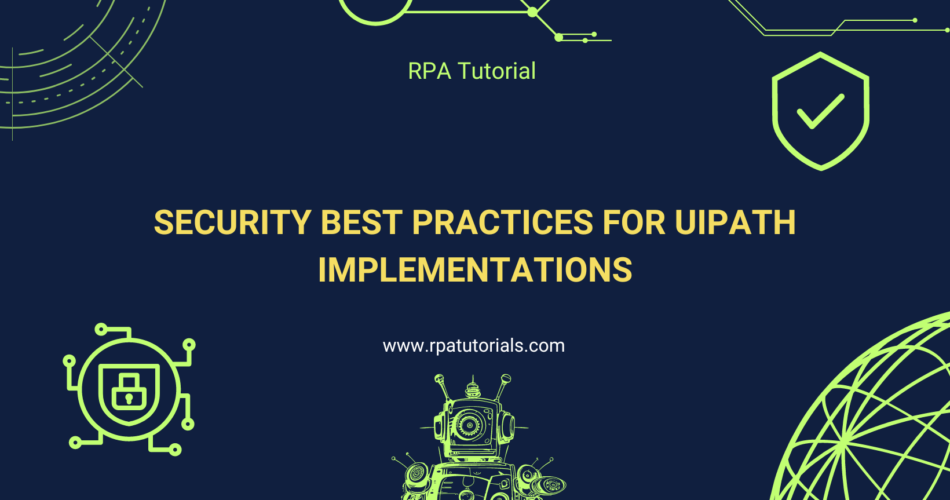As organizations increasingly adopt robotic process automation (RPA) to streamline operations and boost productivity, ensuring the security of these systems is crucial. UiPath, a leading RPA platform, provides powerful tools for developing and managing automation workflows. However, like any technology, it must be deployed with a strong focus on security to protect sensitive data and maintain operational integrity. This post explores best practices for securing your UiPath implementations, ensuring your automation processes are both efficient and secure.
1. Secure Development Practices
Code Reviews and Static Analysis
- Regularly conduct code reviews and use static analysis tools to identify potential security vulnerabilities in your automation scripts.
- Ensure adherence to coding standards and best practices to minimize risks.
Minimal Privilege Principle
- Design workflows to operate with the least privilege necessary.
- Avoid using administrative accounts for tasks that can be performed with lower privileges to reduce the risk of malicious activities if credentials are compromised.
2. Credential Management
Use Secure Credential Storage
- Leverage UiPath Orchestrator’s built-in credential store to securely manage sensitive information.
- Avoid hardcoding credentials directly into automation scripts or configuration files.
Regular Credential Rotation
- Implement a policy for regular rotation of credentials to minimize the risk of unauthorized access.
- Integrate with enterprise credential management solutions to automate this process.
3. Network Security
Encrypted Communication
- Ensure all communications between UiPath components (Studio, Robot, Orchestrator) are encrypted using SSL/TLS to prevent data interception and man-in-the-middle attacks.
Firewall Configurations
- Restrict network access to UiPath Orchestrator and robots through proper firewall configurations.
- Only allow necessary traffic and block unused ports to reduce attack vectors.
4. Role-Based Access Control (RBAC)
Define User Roles and Permissions
- Implement RBAC in UiPath Orchestrator to control access based on user roles.
- Define clear roles with specific permissions tailored to the needs of different user groups (developers, admins, business users).
Regular Access Reviews
- Periodically review user access and permissions to ensure they align with current job responsibilities.
- Remove or update access rights for users who change roles or leave the organization.
5. Secure Logging and Monitoring
Centralized Logging
- Enable centralized logging for all UiPath components.
- Use log aggregation tools to collect and analyze logs for suspicious activities and potential security incidents.
Real-Time Monitoring
- Implement real-time monitoring and alerting for critical events such as failed login attempts, unauthorized access, or changes to sensitive workflows.
- Use security information and event management (SIEM) systems for comprehensive monitoring.
6. Data Protection
Data Encryption
– Encrypt sensitive data both at rest and in transit using strong encryption standards to protect data stored in databases, files, and other storage mediums.
Data Masking
- Mask sensitive data within automated workflows where possible to ensure that personal or confidential information is not exposed during processing.
7. Regular Security Audits
Internal and External Audits
- Conduct regular security audits and assessments of your UiPath environment.
- Engage external security experts to perform thorough evaluations and identify potential weaknesses.
Compliance Checks
- Ensure your UiPath implementations comply with relevant regulatory requirements and industry standards such as GDPR, HIPAA, and ISO 27001.
- Regular compliance checks help in maintaining adherence to these standards.
8. Incident Response Plan
Develop an Incident Response Plan
- Prepare a comprehensive incident response plan specifically for your UiPath environment.
- Define clear procedures for identifying, containing, and mitigating security incidents.
Regular Drills
- Conduct regular incident response drills to test the effectiveness of your plan.
- Use these drills to train your team and refine your response strategies.
9. Patching and Updates
Keep UiPath Updated
- Regularly update UiPath Studio, Robot, and Orchestrator to the latest versions.
- Apply security patches and updates promptly to protect against known vulnerabilities.
Update Dependencies
- Monitor and update third-party libraries and dependencies used in your automation workflows.
- Outdated dependencies can introduce security risks.
10. User Training and Awareness
Security Training Programs
- Implement ongoing security training programs for all users involved in UiPath development and operations.
- Educate them on the importance of security best practices and how to recognize potential threats.
Promote a Security-First Culture
- Foster a culture where security is a top priority.
- Encourage users to report suspicious activities and potential security issues without fear of repercussions.
Conclusion
Securing your UiPath implementations requires a multifaceted approach, encompassing secure development practices, robust credential management, stringent access controls, and continuous monitoring. By adhering to these best practices, you can significantly reduce the risk of security breaches and ensure the integrity and confidentiality of your automated processes. As the landscape of cyber threats evolves, staying vigilant and proactive in your security measures will help safeguard your organization’s RPA investments.

Great article